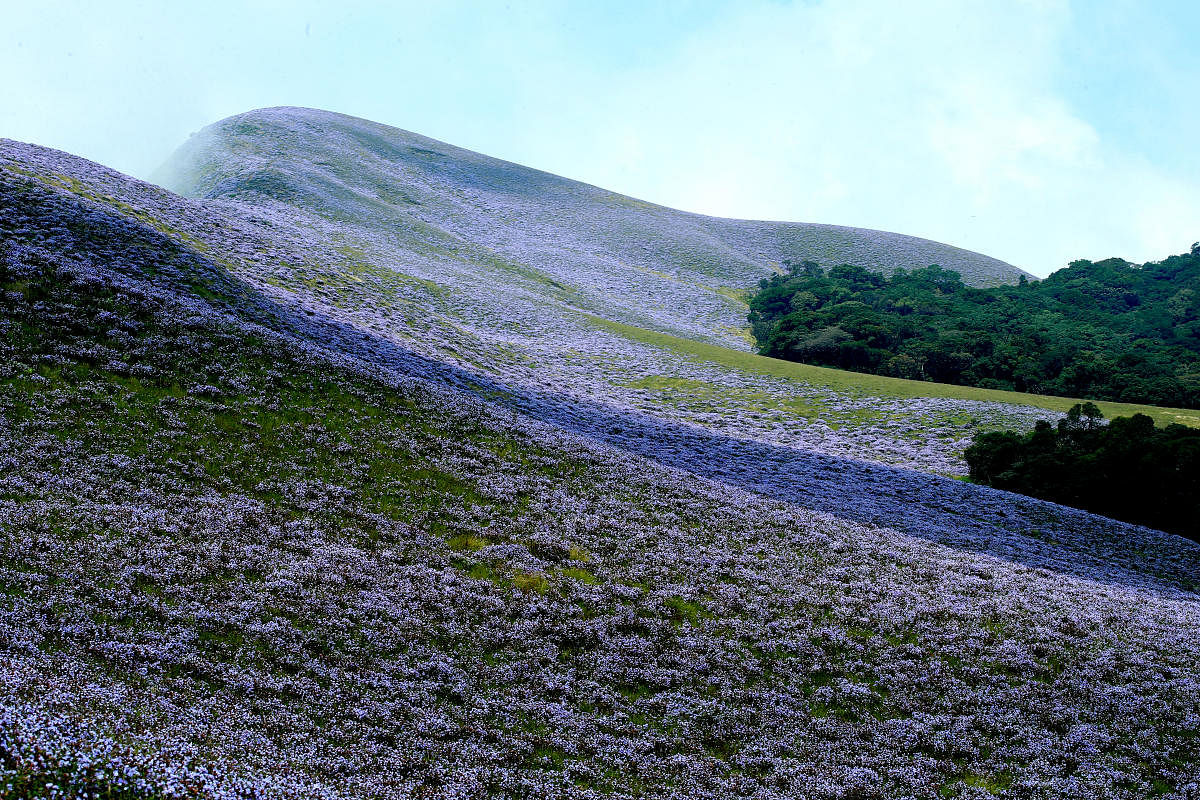
Curtains are finally drawing on the much-awaited Neelakurinji season, a time when the hillsides of Munnar are bathed in a dream-like purple cover that occurs only once every 12 years. But with Kerala still reeling under the trauma of the August flooding, many doubt this season can bring in cheer.
Those who visited the area recently are of the opinion that not much of the magic is lost, despite the widespread devastation. As per the primary calculation by the Munnar Hotel and Restaurant Association (MHRA), Munnar faced losses of over Rs 110 crore during the season. The flood and continuous rain affected the flowering pattern and the flowers had rotten in most parts of the Eravikulam National Park and Kolukkumala, according to forest officials.
“Most of the hotels and resorts in Munnar received only 10% to 15% bookings during the Neelakurinji flowering season. Presently, the local tourists alone visit Munnar and they return the same evening, which is a blow to the hotel industry,” said to MHRA president V V George.
“Most of the hotels and resorts had invested millions of rupees in the sector ahead of the Neelakurinji flowering season. But the flood washed away our hopes,” he added.
“After the floods, we contacted travel agents of various states to give a leg-up to the tourist flow with the motto ‘Kerala is back and Kerala is safe.’ But most travel agents cancelled their Kerala trips this year, while some of them are postponed to next year. We requested the government to immediately complete the construction work of the roads and welcome the tourists back to Kerala,” George adds.
However, the statistics from Idukki district administration show that over two lakh tourists visited Eravikulam National Park, Kolukkumala and Vattavada to witness the flower fete. During the previous season, in 2006, over 3.5 lakh tourists had visited the spots.
Forest department opened ticket counters in Chatta Munnar and Old Munnar HATC stadium during the season. In three places, the ticket counters remained closed from October 30 leaving open the counter at Rajamala alone, according to forest department sources.
Shattered hopes
The tourism department had expected a whopping eight lakh tourists for the season and had made massive arrangements. “The flood and landslides affected tourist entry into Munnar and it was a hit below the belt. We expected over 4.5 lakh tourists during this season. The heavy monsoon also caused a delay in the season,” said Munnar wildlife warden R Lakshmi.
Serial landslides and floods that happened on August 15 damaged several roads and bridges in and around Munnar and isolated the region for many days. A landslide destroyed the Periyavara bridge then, disrupting the traffic on the Munnar-Marayoor route. The bridge also connects tourists to Eravikulam National Park.
Later, PWD officials constructed a temporary bridge in the region and threw it open to traffic. Traffic remained disrupted for many days on one of the main routes to Munnar: the Kochi-Dhanushkodi National highway. Presently, however, traffic movement has resumed on all major routes.
Earlier, it was expected that the main Neelakurinji flowering season would start in the last week of July and extend for three months. But due to heavy rainfall, the flowering season was delayed by over two months and started only on the first week of September.
Business badly hit
Lack of tourist presence largely affected small scale vendors in Munnar, too.
“We expected heavy tourist rush and better business during the season. Most of the merchants largely stocked their goods before the season. But the flood hit our hopes,” said Joseph Saju, a smallscale vendor in Munnar.
In July, the scare of deadly Nipah virus was another blow the tourism sector in Idukki had to face, despite no cases being reported from the district. That alone allegedly kept over 70% of tourists from visiting the district which has many alluring tourist destinations under the same skies: Munnar, Thekkady and Wagamon.
Right now, the state is reeling under a heatwave due to poor north-east monsoon. However, thankfully, Munnar is still cool with 7 degrees Celsius being recorded. This is expected to pull more tourists to the destination.
The winter seems to be coming a bit early this year, because normally it starts on the first week of November and goes on till the second week of January. So, the industry hopes to reclaim its lost sheen if nature blesses it with a real cool climate.
(The writer is a member of The NewsCart, a Bengaluru-based media startup)